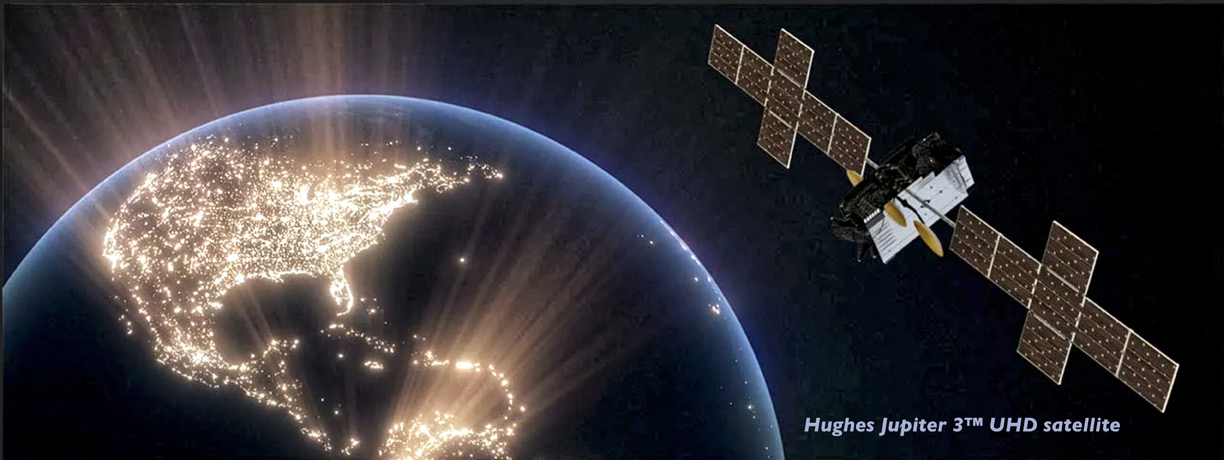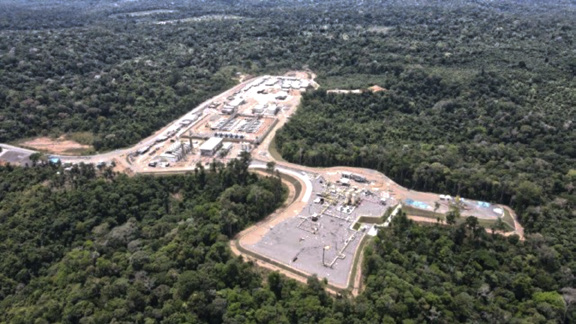President and General Manager of the International Division at Hughes
Dan Losada, vice president & general manager of the International Division at Hughes, leads the company’s international sales team, responsible for satellite broadband systems sales around the globe, and maintaining the company’s competitive edge as the world’s leading VSAT provider.

Dan has more than 30 years of experience in satellite and wireless communication technology development and implementation. His knowledge of the complete life cycle of satellite technology makes him one of the main global sources of information and advice on connectivity projects, as well as a reference for leaders in the satellite community in the public, industrial, and military sectors.

Dan Losada
Prior to his current role, Dan was senior director of the Defense and Intelligence Systems Division at Hughes, supporting the U.S. military during its transition to Internet Protocol (IP)-based broadband systems.
Dan earned a Bachelor of Science and Master of Science in Electrical Engineering from the University of Illinois at Urbana-Champaign. He is also PMP certified. Dan has published papers on communication systems and design and speaks frequently at industry conferences and panels worldwide.
Mr. Losada, Hughes has played a central role in expanding digital connectivity across Latin America. What are the biggest challenges and opportunities in bridging the digital divide in the region?
Dan Losada
The digital divide in Latin America is not a new challenge. However, as technology evolves and digital transformation accelerates, the need to close that gap has become more urgent.
Across the region, tens of millions of people still live in areas where access to reliable, high-speed internet is either limited or nonexistent, according to the
Inter-American Development Bank, which estimates that more than 77 million people in Latin America and the Caribbean lack broadband access today.
For these communities, connectivity is a gateway to education, telemedicine, financial inclusion, and government services. Connectivity in remote regions is also critical for governments and businesses to offer services. The use of AI / ML to improve efficiency and reduce costs requires reliable connectivity.
Geography remains the most significant obstacle. Latin America is home to diverse and difficult terrain, from dense rainforests and mountains to deserts and remote islands. These physical conditions often make terrestrial infrastructure like fiber or cable both impractical and expensive

Hughes operations in Brazil, photo courtesy
of the company
Despite these difficulties, this is also where the greatest opportunity lies. At Hughes, we see these underserved regions as critical areas for innovation. Satellite connectivity, especially when integrated with terrestrial and wireless technologies, is uniquely suited to overcome the barriers of geography.
Our work includes delivering cellular backhaul, community Wi-Fi, and broadband solutions tailored to the needs of specific communities.
Solving the digital divide is not only about deploying technology. It also requires community engagement, long-term sustainability, and strategic partnerships. We work closely with governments, telecom operators, and local organizations to ensure that our solutions are not only accessible but also viable for the long term. When we connect a remote village, we help establish the foundation for growth and opportunity.
Can you share a project where Hughes brought connectivity to a remote or underserved region in Latin America?
Dan Losada
Hughes has played a pivotal role in bringing connectivity to remote and underserved regions across Latin America, with standout projects in both Brazil and Colombia.
In Brazil, Hughes provided connectivity to a network of remote solar energy sites. These installations were dispersed across challenging terrain and lacked access to any traditional infrastructure.
To support this network, we implemented a combination of technologies. Our JUPITER™ System, a global standard for satellite ground systems, formed the backbone of the solution. For mobile assets, we deployed portable BGAN terminals that provided reliable satellite links.
At larger fixed sites, we established full private wireless networks, drawing on our 5G expertise and deep integration capabilities in Brazil. This project was a comprehensive solution for connectivity that addressed performance, mobility, and reliability.
We leveraged local partners to ensure efficient on-the-ground execution and used centralized tools to monitor and maintain network operations.
In Colombia, Hughes is a key contributor to the Juntas de Internet – Comunidades de Conectividad initiative, a national strategy led by the Ministry of Telecommunications to close the digital divide in rural and remote areas. These non-profit community organizations are formed by local residents who collaborate to manage and operate their own fixed internet service.
Through a community-based fee model, they provide affordable access to connectivity, reinvesting revenues to maintain and improve infrastructure. The initiative promotes economic, social, and educational development in regions where commercial or technical barriers have historically limited Internet access.

Between late 2024 and early 2025, Hughes deployed a total of 182 Juntas de Internet across various regions of Colombia, directly benefiting over 18,000 households.
Together these projects reflect Hughes commitment to bridging the digital divide and delivering innovative, scalable connectivity solutions that empower communities and support national development goals.
How are satellite providers and telecom operators redefining their roles in Latin America’s connectivity ecosystem?
Dan Losada
Across Latin America, the connectivity landscape is shifting from large-scale fiber deployments to more flexible, hybrid network models. Governments and telecom operators are increasingly recognizing that traditional approaches are not enough, particularly in rural or hard-to-reach areas. This shift is driving a new model based on strategic partnerships and integrated technologies.
In this evolving ecosystem, satellite providers like Hughes are redefining their roles, moving beyond bandwidth providers to become strategic partners that bring unique capabilities to support network expansion.
We work directly with mobile network operators to deliver satellite-based backhaul solutions that enable fast deployment of 4G and 5G services in places where terrestrial infrastructure is not viable. In countries such as Colombia, Brazil, and Peru, we support hundreds of rural base stations, helping operators extend their reach efficiently and cost-effectively.
Satellite providers are key players in building resilient, scalable networks that meet the real needs of Latin American communities, which enables governments to expand digital services more equitably and empowers telecom operators to reach new markets faster and more efficiently.
How is Hughes helping Mobile Network Operators (MNOs) bring 4G and 5G services to remote Latin American communities?
Dan Losada
Mobile network operators across the region face the same fundamental challenge: how to extend 4G and 5G coverage to rural or geographically complex areas in a way that is both economical and technically feasible.
At Hughes, we offer a full suite of satellite-based backhaul solutions that solve this problem. Our systems are designed to integrate seamlessly into mobile networks, enabling rapid and cost-effective deployments. We provide everything from the satellite link to the terminal installation, as well as ongoing monitoring and management services.

One of our key strengths in Latin America is our local presence. We have established infrastructure, partners, and teams on the ground in major markets such as Brazil, Colombia, and Mexico. This allows us to tailor our services to national regulatory frameworks and market requirements, ensuring smooth deployments and ongoing support.
With the growing demand for high-speed, low-latency services, we’ve also ensured that our JUPITER™ System is 5G-ready. This future-proof design allows operators to confidently build rural networks today that will support emerging applications in the years ahead.
What are the key technical challenges when integrating satellite and terrestrial networks, and how is Hughes solving them?
Dan Losada
Combining satellite and terrestrial networks, especially for 4G and 5G, introduces several technical challenges. Latency is a major consideration, as satellite links—particularly from geostationary satellites—introduce longer round-trip times compared to fiber. Additionally, maintaining synchronization with mobile network cores can be complex.
At Hughes, we tackle these challenges with a combination of advanced technologies and close collaboration with our partners. We use TCP acceleration and carrier aggregation to enhance throughput and reduce latency-related performance issues. We also implement intelligent traffic routing using software-defined networking tools, ensuring that data always takes the most efficient path.
The JUPITER™ System was engineered with these challenges in mind. It supports direct integration with mobile core networks and is designed to manage performance parameters critical to 5G. We also work with mobile operators to fine-tune the system to their specific needs, ensuring the best possible experience for end users.
Through close collaboration with mobile operators, we fine-tune our systems to meet specific deployment needs, enabling them to expand their networks into underserved areas without compromising on performance or reliability.
How does Hughes support governments across Latin America in closing the digital divide?
Dan Losada
Government partnerships are central to our strategy in Latin America. We work closely with national, regional, and municipal authorities to bring connectivity to areas that are not served by the private sector alone. These projects often focus on schools, health clinics, and public institutions that are critical to community wellbeing.
Our managed services model is especially valuable in government deployments. We don’t simply deliver a satellite link and walk away. Instead, we provide a complete solution that includes installation, maintenance, performance monitoring, and technical support. Governments benefit from guaranteed service levels, 24/7 monitoring, and built-in compliance with data security and privacy regulations.

A great example of this is our work in Colombia, where we support connectivity programs that have reached more than 15,000 schools in rural areas. These efforts go beyond just bandwidth. We also provide Wi-Fi access, routers, solar-powered equipment, and training for school staff.
Our goal is to be a long-term partner to governments as they expand digital services. We build scalable solutions that can grow over time and adapt to changing priorities, whether that means expanding access to telemedicine, supporting e-learning, or improving public safety communications.
With LEO constellations becoming more prevalent, how will they shape the future of Hughes offerings in Latin America?
Dan Losada
LEO satellites are reshaping the future of connectivity in Latin America. With their lower latency and higher capacity, they open the door to a wide range of real-time applications, from cloud-based enterprise tools to video conferencing and smart city services.
At Hughes, we see LEO as a critical component of a broader multi-orbit strategy that combines LEO, geostationary (GEO) satellites, and terrestrial infrastructure. This hybrid approach offers the best of all worlds: broad coverage, low latency, and built-in redundancy.

We’re already implementing this approach through our partnerships with providers like Eutelsat and it’s OneWeb LEO constellation. Our JUPITER™ platform is designed to seamlessly integrate across orbits and service types. This flexibility allows us to tailor solutions for different use cases, from government programs and mobile backhaul to enterprise and community connectivity.
As LEO networks expand in Latin America, we will continue to combine them with our terrestrial and GEO services to deliver high-performance, affordable, and resilient connectivity across the region.
Latin America’s digital future depends on extending connectivity to every corner of the region. At Hughes, we are committed to making that future a reality. Through advanced satellite technologies, deep local engagement, and a focus on long-term partnership, we’re helping bridge the digital divide—community by community, connection by connection.

